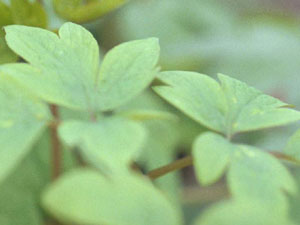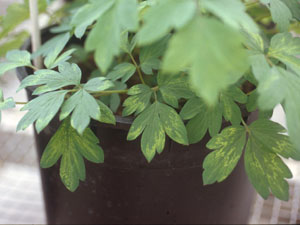A Case Study to Determine the cause of Chlorosis in a Crop of Cut Dicentra spectabilis
By Marci Spaw, Kimberly A. Williams, Laurie Hodges, Ellen T. Paparozzi and Ingrid L. Mallberg
The Grower

Close-up of Dicentra spectabilis’ heart-shaped flowers. (photo courtesy of Ingrid Mallberg)
The grower, Maria Flint, is forcing Dicentra spectabilis as cut flowers for Valentine’s Day sales for the first time. While Dicentra is common in spring perennial gardens across the central Great Plains, it is a relatively minor cut flower crop. Because it blooms from late April until early June under natural environmental conditions, it must be forced into flower for Valentine’s Day sales. But with arching racemes of delicately formed heart-shaped flowers from which it takes its common name, bleeding heart, it is an appropriate crop for the Valentine’s Day market.
Flint’s Flower Farm specializes in production of unique cut flowers for local markets in Lincoln and Omaha, Nebraska. The flower farm is located between these two population centers in Cass County in the eastern third of the state, and the farm falls at 41°N latitude. Flint’s Flower Farm produces cut flowers in the field, in high tunnels, and in one heated greenhouse, so production, and thus cash-flow, is year-round. The farm’s water source for irrigation is municipal water.
Production Information
While Dicentra can be produced from seed, this species is typically grown from crowns for cut flower production. For cut Dicentra stems to be ready to harvest by Valentine’s Day, a 5-8 week cropping cycle is recommended. Maria purchased her Dicentra crowns from Walters Gardens, Inc. in Zeeland, Michigan. She planted the crowns on December 18 in gallon nursery pots filled with a soilless medium of peat : perlite : vermiculite (2:1:1 by volume) which had been amended with dolomitic lime to adjust the pH to within the recommended range of 7.0 – 8.5. The pots were set on a staggered spacing of 12-inch centers.

Dicentra crowns ready to be planted (photo courtesy of Ingrid Mallberg)
PDF: Forcing Bleeding Heart for Spring SalesGrowing temperature was 70 F day and 55 F night in the farm’s single heated greenhouse structure. Three weeks after the crowns were planted, fertilization began with 200 ppm N from 15-16-17 Peter’s Peat-Lite Special Fertilizer which was applied at every watering through a Hozon proportioner; the plants were watered 2 to 3 times per week. Yellow sticky cards were placed throughout the crop to monitor for flying insect pests as part of a scheduled scouting program throughout the production cycle. The crop was not sprayed with any pesticides or plant growth regulators. Very little information is known about forcing Dicentra as a cut flower, but Maria was able to find a useful Extension publication by Tina M. Smith from the University of Massachusetts Amherst that guided her production strategy (linked at right).
The Problem
On the 23rd of January, Maria noticed subtle chlorosis appearing on about a third of her Dicentra crop. It tended to be interveinal and did not quite reach the leaf margins. In general, it was the older leaves that were exhibiting this disturbing chlorotic discoloration. Maria frequently visits with an extension horticulturist about production and marketing ideas, and this contact is also valuable when problems arise. Maria is able to explain the situation during a phone conversation.
Excerpts from Phone Conversation with Extension Horticulturist, January 23rd
Extension Horticulturist:
Okay, you have described some of the basic production practices for your cut dicentra crop. But I think I need to hear a little more detail about the symptoms. Slight yellowing of the foliage can be caused by a lot of things and it is difficult to diagnosis the cause without a picture or an actual plant; even then, it can be tough.
Maria:
Yes; I just want to pick your brain and kind of run through the list of possibilities.
Extension Horticulturist:
Sure. Categories of potential problems boil down to nutritional, environmental, insect or disease, or even a combination of these. Let’s try to rule-out some of these as causes as the starting point to get to the bottom of what is really going on.
Maria:
Good plan. Well, the chlorosis is subtle and it isn’t even showing on all of my plants.
Extension Horticulturist:
Do you see patterns of affected plants, for example, in one section of the greenhouse or on one bench, or is it pretty randomly distributed throughout the crop?
Maria:
I would say that it is random…showing on plants here and there, but no definite pattern.
Extension Horticulturist:
How do the roots look? To the edges of the pot? White or brownish?
Maria:
You know, I really haven’t checked the root system yet.
Extension Horticulturist:
Do go ahead and knock several plants out of the pots to check on the root system. Good roots grow good shoots, so you’ll want to get in the habit of checking root systems routinely. What about any insect problems?
Maria:
I have been scouting regularly. I put out yellow sticky cards and do counts of what I trap on a weekly basis, even though it can be hard to fit that into my schedule sometimes. Fungus gnats and shore flies have been a nuisance throughout the crop, but I’m not seeing anything else that concerns me at this point. No thrips, whiteflies, aphids. Nothing else.
Extension Horticulturist:
That’s all good news. Let’s talk a little more about nutrition, then. You said that you are fertigating with 15-16-17 Peter’s Peat-Lite Special, applying 200 ppm N…and you added no other pre-plant amendments except for the dolomitic lime. The symptomology of chlorosis would be consistent with deficiency of a handful of nutrients, especially with you catching the problem this early. It’s less likely a toxicity problem, though that’s a possibility, as well. It’s really hard to tell when the plants are just starting to express a problem. Do you know what your root medium pH and Electrical Conductivity are? That information would shed quite a bit of light on the situation.
Maria:
I haven’t run those tests on this crop, but I can do that and get back to you.
Extension Horticulturist:
Great! EC will give us an idea of how much fertilizer is available to the plant; if it’s really low, that may indicate a general nutrient deficiency that may be traced to a fertilizer injector not working properly or something along those lines. If the EC is very high, that may indicate salt toxicity that has burned the roots, and when roots can’t take up nutrients, the symptoms often manifest themselves as nutrient deficiencies. Now pH can be a little more complicated. If it’s on the high side, that could mean that your micronutrient cations like Fe, Mn, Zn, and Cu are not readily available…and Fe deficiency often appears as intervienal chlorosis of the upper leaves. If the pH is on the low side, perhaps Mg or Ca are beginning to be tied up. Mg deficiency often appears as intervienal chlorosis of the lower leaves.
Maria:
Do you think that I should do anything at this point…spray something?
Extension Horticulturist:
Well, we really don’t have much information to go on, at this point. We haven’t ruled out nutrition, or disease, for that matter, as a source of the problem. You would be fine to continue fertilizing at each watering; because the symptoms remind me of Ca deficiency as much as anything else, you could even apply a one-time drench of 100 ppm Ca from CaCO3 if the pH turns out to be a little low. In that case, even if Ca deficiency is not related to the problem, the drench will not hurt the crop.
Twelve days later, as Valentine’s Day neared, the chlorosis continued to worsen and younger leaves were beginning to wrinkle, pucker, and exhibit slight chlorosis as well. Maria needed to quickly figure out what was causing this disorder because she did not know if it would impact the development of the bleeding heart flowers for which she had already lined up Valentine’s Day sales. In addition, she wanted to identify the problem so that she could avoid it in the future.

Subtle chlorosis on January 23
(photo courtesy of Ingrid Mallberg)

Symptoms appear on the older leaves first (photo courtesy of Ingrid Mallberg)
The Assignment
Time and Money Budget FormYour assignment is to put yourself in Maria’s shoes: decide what test(s) you would run to sort out the problem. Justify your decision to run each test and keep track of its cost by completing the Time & Money Budget Form. The goal is to solve the problem by spending the least amount of money, but time is of the essence because the market date is nearing and the symptoms of the disorder are worsening.
The starting point is to determine what the crop’s history reveals about the problem. The short article “What’s Wrong With My Plant’s’ by Margery Daughtrey from Cornell University provides useful strategy. Chlorosis can be caused by many things, certainly, but you can glean several probable leads from what is known. What information do you need to validate or eliminate a particular known cause of the type of chlorosis described?
Listed below are means to gain additional information to solve the problem. Some information can be gathered quickly “in-house” by Maria herself whereas other information may be provided in the form of test results or from a conversation with an expert in the field. Answer the questions on the Time & Money Budget Form to justify your conclusions.
| Action-type | Diagnostic Action | ||
| [Click on links below to access diagnostic test results] | Time | Cost | |
| In-House | Research Reference Books | 1 Day | $0 |
| Plant Inspection & Sticky Card Count Record | 1 Day | $0 | |
| Follow-up Conversation with Extension Horticulturist after completing in-house pH and Electrical Conductivity (EC) tests | 2 Days | $0 | |
| Outsource:Nutrition | Water-based Media Extraction | 6 Days | $63 including overnight shipping |
| Acid-based Soil Extraction | 6 Days | $69including overnight shipping | |
| Water Analysis | 5 Days | $52including overnight shipping | |
| Plant Tissue Analysis | 8 Days | $40 | |
| Outsource:Disease | Conversation with Extension Plant Pathologist | 7 Days |
$0 |
| Commercial Diagnostic Disease Lab | 5 Days |
$94 | |
| Outsource:Insect | Email Exchange with Extension Entomologist | 4 Days |
$0 |
If you have any questions, comments or would like to receive teaching notes pertaining to this case study please contact:
Kimberly A. Williams, Professor of Floriculture
Kansas State University
Department of Horticulture, Forestry, and Recreation Resources
2021 Throckmorton Plant Sciences Center
Manhattan, Kansas 66506-5506
kwilliam@ksu.edu
785-532-1434


